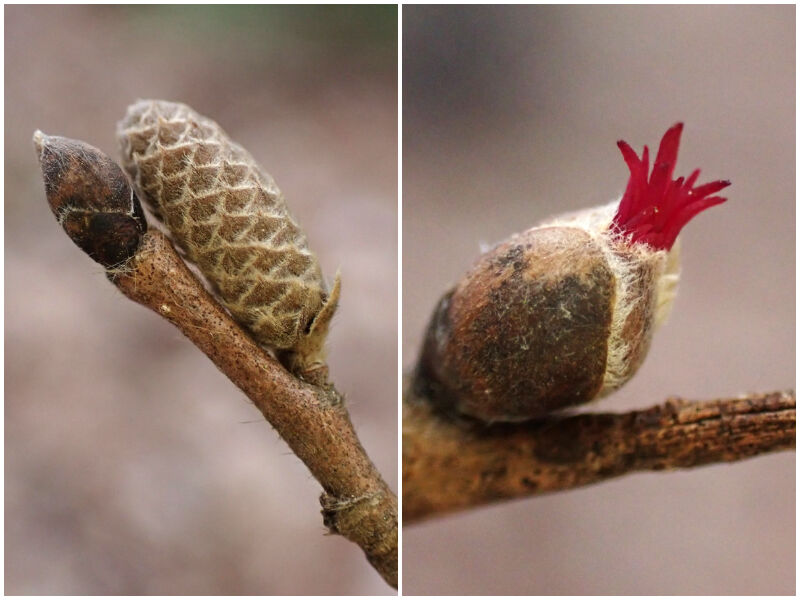“Let’s start with the evergreens,” I told the small group who’d showed up for my tree identification program. Picking up a white pine bough, I plucked off a bundle of needles. “Pines cluster their needles in a group called a fascicle,” I lectured, “and they are held together at the base by a sheath.” Fascicle is one of my favorite botanical words, and I loved watching these newbies roll it around on their tongues. After years of formal training in plant identification, I’ve acquired a lot of vocabulary words that I don’t get to use very often.
I’ve also acquired some silly mnemonics for remembering plant ID. “Notice that these needles come in fascicles of five. That means it’s a white pine. W-H-I-T-E: white has five letters. Five needles, five letters. Also, the growth form of their needles makes white pines look like they have clouds on their branches, and clouds are white.”
Folks humored me, nodding their heads in understanding. After examining a couple more evergreens, we turned to the jumble of bare sticks I had spread on the table. To most people it would look like a pile of junk. To me, it looked like a gathering of old friends with easy-to-see differences. The vocabulary started flowing.
Maples, ashes, dogwoods, and viburnums have opposite arrangement. Their twigs and buds sprout directly across from each other in pairs, while other trees place their buds and twigs singly, in an alternate arrangement. This is a good place to start your ID.
Then check out the buds more closely. Buds are miniature packages of new growth, pre-formed last summer, and just biding time until they can burst open in a flurry of new growth and elongation. Baby leaves, twigs, and flowers may all be crammed into the same bud, or special buds may hold the flowers. Tiny, tough, modified leaves cradle all that tender new growth, protecting it from desiccation. These bud scales give great clues to a plant’s identity. In sugar maples, the bud scales are a rich caramel color, and they are imbricate. Another one of my favorite botany vocab words, imbricate means overlapping like shingles.
On red maples, the scales are imbricate, but there are fewer of them, and they are arranged symmetrically in pairs. If the scarlet buds and new growth on red maples aren’t enough it give away their ID, the buds also have distinctive “ciliate margins” of tiny white hairs edging each red bud scale.
I could see the gears turning as people squirreled away this information in preparation for the quiz. Shrubs always seem the most difficult to identify in winter, since they’re smaller, and lack the distinctive bark of a paper birch or red pine. But if you look closely, the ID is in the details.
Beaked hazel is one of the most common understory plants in these woods. Also known as “bear nut”, they are an excellent wildlife plant. From afar, they look like any other spindly shrub. Up close, their fuzzy, two-toned buds are quite handsome. Just two or three dark brown, imbricate scales clasp the bottom of the bud.
The light brown, inner scales toward the tip are almost valvate (a term that means two symmetrical scales that come together like a clamshell.) They are also pubescent. The fine hairs that cover the scales serve to protect the bud from cold and dryness. In the spring—before the leaves unfurl—a tiny, red, octopus flower will sprout from the tip of the bud. In the leafless woods, wind can easily bring it a dusting of pollen. That pollen comes from tiny catkins on the hazel. All winter, the catkins are tan, fuzzy and compact. Any day now, they’ll elongate into pendulous yellow strings of flowers.
These buds and catkins all formed last summer, while leaves still clung to the trees. It’s in the tree’s best interest to make buds while the sun shines, and energy is plentiful. So there is only a brief time—just after spring bud break—when there are no buds to look at.
Fascicles. Arrangement. Imbricate. Ciliate. Valvate. Pubescent. Catkins. This language may seem complicated and excessive, but for humans, to name things is to see things, and vice versa.
In Braiding Sweetgrass, botanist Robin Wall Kimmerer philosophizes about the language of science. “Listening in wild places, we are audience to conversations in a language not our own. I think now that it was a longing to comprehend this language I heard in the woods that led me to science, to learn over the years to speak fluent botany. A tongue that should not, by the way, be mistaken for the language of plants. I did learn another language in science, though, one of careful observation, and an intimate vocabulary that names each little part. To name and describe you must first see, and science polishes the gift of seeing.”
As the students moved away to test their new knowledge, I hung back for a second, savoring the beauty of “see through” season in the leafless woods, and the words I have to see it with.
Author’s note: This article is reprinted from 2015.
Emily’s award-winning second book, Natural Connections: Dreaming of an Elfin Skimmer, is available to purchase at www.cablemuseum.org/books and at your local independent bookstore, too.
For more than 50 years, the Cable Natural History Museum has served to connect you to the Northwoods. The Museum is closed until May 1 to construct our new exhibit: “Anaamaagon: Under the Snow.” Our Winter/Spring Calendar of Events is open for registration! Follow us on Facebook, Instagram, YouTube, and cablemuseum.org to see what we are up to.
Last Update: Mar 20, 2024 8:40 am CDT
















